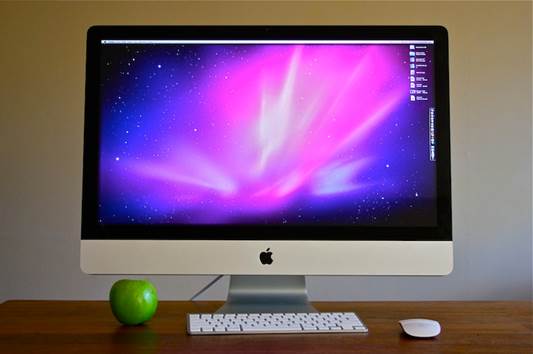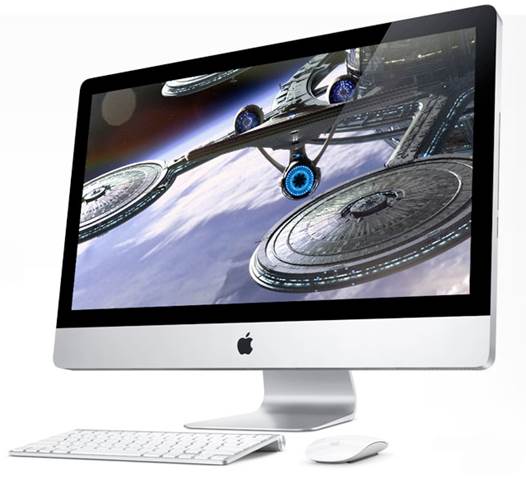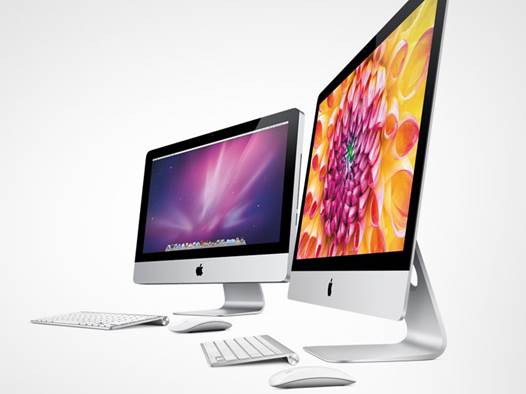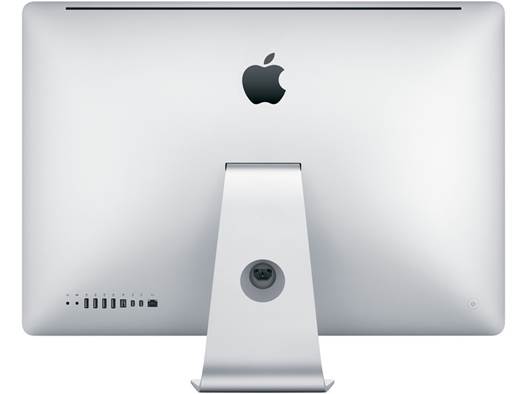Does the new all-in-one’s 5mm edge
justify the design tradeoffs?
Apple has updated its largest all-in-one
desktop computer, the 27-inch iMac, with many under-the-hood changes, but the
first thing people notice is how thin it is. Does the new iMac’s impressive 5mm
edge justify losses in functionality?
Apple offers its new 27-inch iMacs in two
standard configurations, both using Intel’s quad-core Ivy Bridge processors.
The high-end $1999 model sports a 3.2GHz Core i5 processor, while the low-end
$1,799 model uses a 2.9GHz Core i5. In our tests the 3.2GHz model was between 5
and 7 percent faster than the 2.9GHz model at handling processor-intensive
tasks. Both CPUs can use Turbo Boost to run at speeds of 3.6GHz for brief
periods of time. For $200 more, you can order a 3.4GHz quad-core Core i7 CPU
that supports Turbo Boost up to 3.9GHz. The optional Core i7 also supports
Intel’s Hyper-Threading technology, which lets applications that can take
advantage of multiple cores address eight virtual cores instead of the four
physical ones.

Apple
offers its new 27-inch iMacs in two standard configurations
All 2012 iMacs ship with 8GB of RAM, up
from 4GB in the previous generation. The 27-inch iMacs ship with 7200-rpm, 1TB
hard drives as standard equipment – just as the 2011 27-inch iMac did.
Both new versions of the 27-inch iMac come
with four memory slots. Two slots hold 4GB SO-DIMMs, and two are open. Apple
charges $200 to increase the RAM from 8GB to 16GB at the time of purchase, but
good third-party RAM costs under $100.
The new iMac has four USB 3.0 ports, a
gigabit Ethernet port, a headphone/audio-out port, and two Thunderbolt ports –
but no audio-in or FireWire port. The handy SDXC card slot has moved from the
side of the iMac to a less handy spot on the back, near the ports. The new
model doesn’t include an internal optical drive, so if you want to burn, rip,
watch, listen to, or back up to CDs or DVDs, you will have to buy an external
peripheral, such as Apple’s $79 USB SuperDrive.
For graphics processing, the $1,799 iMac
uses the Nvidia GeForce GTX 660M with 512MB of GDDR5 memory, while the $1,999
iMac uses an Nvidia GeForce GTX 675MX with 1GB of GDDR5 memory. For an extra
$150, you can upgrade the $1,999 model to the Nvidia GeForce GTX 680MX with 2GB
of GDDR5 memory.
No reflection on you

Apple
eliminated the 2mm air gap that used to separate the iMac’s glass cover from
the LCD panel
As part of the iMac’s physical redesign,
Apple eliminated the 2mm air gap that used to separate the iMac’s glass cover
from the LCD panel. Now the glass adheres directly to the panel, reducing glare
and screen reflection but also increasing the cost of replacing the front
glass: If the glass breaks on this model, you have to replace the whole
display. Already, in the past, only the bravest of souls dared to open an iMac;
but the new design’s use of adhesive instead of magnets to connect the screen
to the case basically locks the iMac down to all but certified repair folk.
One positive benefit of this major design
change in tandem with a new antiglare coating process – is a very noticeable
reduction in screen reflection. Apple claims to have reduced glare by 75
percent. When I stood in front of a 2011 iMac and a 2012 model, gazing at the
older system was almost like staring into a mirror; but my reflection virtually
disappeared when I looked at the screen of the 2012 model.
Colors on the new iMacs look vibrant and
photographic images pop, with dark blacks adding the appearance of depth. The
iMac’s LED backlit IPS display, with a native resolution of 2560 by 1440
pixels, offers a wide range of good viewing angles, so you and several others
can view content on the iMac screen with little loss of contrast and few color
shifts as you move away from a position directly in front of the center of the
screen.
The iMac’s integrated speakers also
received an upgrade, yielding noticeably warmer and fuller-sounding music on
the new system’s stereo speakers. Increasing the resolution of the built-in
FaceTime camera to 720p and adding a second microphone (to help eliminate
background noise and improve audio quality) enhances videoconferencing.
Drive issues

Colors
on the new iMacs look vibrant and photographic images pop, with dark blacks
adding the appearance of depth
Unlike the new 21.5-inch iMac models, which
switched from using the 7200-rpm hard drive that their predecessors carried to
using slower 5400-rpm drives, both of our 27-inch test iMacs packed 7200-rpm
drives. However, we found an unexpected difference between the hard drives used
in the two 27-inch iMacs. Although not a specification quoted by Apple, one of
the hard drives had twice as much on-board cache as the other and performed
significantly better: The low-end $1,799 iMac came with a speedy Seagate
Barracuda ST1000DM003 hard drive with 64MB of cache, whereas the high-end iMac
had a slower Western Digital WD10EALX Caviar Blue drive with 32MB of cache. The
Seagate-equipped 2.9GHz iMac took 96 seconds to copy and move a 6GB file on the
drive; the WD-bearing 3.2GHz iMac took 146 seconds. Since Apple doesn’t specify
hard-drive brands or offer detailed drive specifications beyond capacity and
rotational speed, you can’t predict which drive will arrive in your iMac. When
we bought a customized 27-inch iMac with a 3.4GHz Core i7, it shipped with the
faster Seagate drive installed as part of its Fusion Drive. Owing to its faster
drive (presumably), our low-end iMac outperformed our high-end system on 9 of
the 15 tests that make up Speedmark8, and the 2.9GHz iMac’s overall Speedmark8
score was 6 percent higher than the 3.2GHz iMac’s score.
Configure-to-order storage options include
a 3TB hard drive (for an additional $150), a 1TB Fusion Drive ($250), a 3TB
Fusion Drive ($400), and 768GB of flash storage (a whopping $1,300 premium).
Fusion Drive is an Apple innovation that marries a roomy 1TB or 3TB standard
hard drive with 100GB of zippy flash storage. The Fusion Drive looks and acts
like a single drive to the end user; but in everyday use, it performs like an
SSD.
Bottom line

The
new iMac’s drastically reduced glare and generous 8GB of RAM will benefit every
user
The new 27-inh iMacs are strikingly
designed, but the loss of internal optical drives and built-in FireWire ports
dampens my enthusiasm for the makeover. The new iMac’s drastically reduced
glare and generous 8GB of RAM will benefit every user. Enhanced FaceTime
cameras, better-sounding speakers, and faster processor sweeten the deal, and
the optional Fusion Drive’s ability to offer an SSD’s speed with a hard drive’s
capacity represents a breakthrough in storage. With only subtle differences in
CPU and graphics performance between the high- and low-end 27-inch iMac models,
your best bet might be to purchase the $1,799 iMac and then put the $200 that
you’ll save by making that choice toward the optional 1TB Fusion Drive.